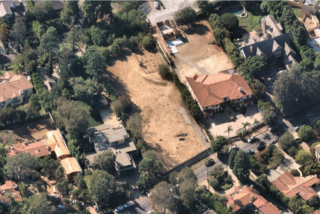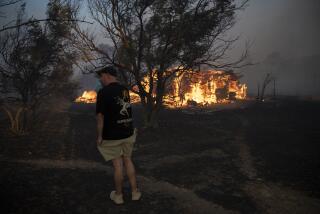Of World Forests and World History : A FOREST JOURNEY From Mesopotamia to North America <i> by John Perlin (W.W. Norton: $19.95; 276 pp., illustrated) </i>
- Share via
As we proceed to demolish the last great forests on Earth in the tropics of both Africa and America, it is easy to believe this catastrophic event is a novelty. True enough, the global congruence of overpopulation, industrialism and deforestation are novel, but it is equally apparent that history has much to say about the symbiosis of civilization and its forests.
As difficult as it is to imagine today, most of what is now the “civilized world” was forest land prior to its conversion for human purposes. Dense stands of ancient Atlas cedar once blanketed the now-barren mountains and hills of northern Africa. Cedars of Lebanon--the source of timber for Solomon’s ships--as well as oak and pine once forested the Holy Land and upper drainages of the Tigris and Euphrates rivers; today these areas are mostly desert or scrub.
The dry, rocky, picturesque hills of Greece, Italy and Madeira, now barely productive enough for grape vines, were once blanketed not only with forests, but with fertile soils. Their rivers were deep and clear, flowing throughout the year, not the droughty arroyos seasonally inundated with silt-laden torrents that characterize the Mediterranean region today. Their very coastlines are altered. Soil washed from the slopes has come to rest in river deltas, extending once sharply defined shorelines far out into marshy shallows and destroying ancient harbors.
John Perlin’s new book, “A Forest Journey,” is like some Greek epic poem spanning 4,000 years of civilization. The refrain is inevitably tragic. It begins with the “Epic of Gilgamesh” about 2000 BC. Gilgamesh penetrated the primordial cedar forest in the mountains south of Mesopotamia to acquire timber necessary for building his city-state of Uruk. According to Perlin, the “Epic” recounts droughts that plagued southern Mesopotamia in the aftermath of deforestation. Subsequently, during the heyday of Sumerian civilization, ships carried oak from Arabia, cedar from Turkey, juniper and sycamore from Syria to the city-states of Lagash and Ur.
One of the immediate consequences of these early logging activities was that the rivers of the Near East soon flowed with silt and dissolved salts, clogging the network of irrigation canals upon which agriculture depended, as well as the river estuaries where principal ports had been established. The water systems could be dredged--at great expense--but the exposure of salt-laden sedimentary rock eventually salinized valley agricultural soils. So far as Perlin is concerned, the subsequent decay of Sumeria was directly correlated with declines in the barley harvest over three centuries.
Deforestation leads not only to environmental deterioration--changes in the hydrologic cycle and erosion--but also has direct economic and political consequences stemming from the loss of inexpensive building material and fuel. Perlin’s accounts of the rise and fall of Aegean civilizations from the third millennium BC, through the decline of Athens after the Peloponnesian War, repeat cycles of rising commerce, industry, military strength and population depending upon high-quality local timber for construction of buildings and ships, and fuel wood for heating, cooking, pottery and bronze smelting.
Early in the cycle, societies often export lumber to finance growth and the newly cleared land provides productive agriculture. Toward the end, they are forced to import wood and substitute other materials while soil fertility declines; living and production costs rise, leading to a degeneration of commercial and military strength.
Perlin equates the decline of Minoan civilization on Crete, circa 1450 BC, with exhaustion of the island’s forests. During its golden age, residences were constructed with lavish use of large wood beams; pottery kilns and bronze furnaces were close to Knossos and produced for export as well as domestic consumption. Later, as local woods were exhausted, Crete traded goods for timber with nearby Pylos in Messenia. Eventually, Crete fell under Mycenaean influence, its economy was reduced to sheep grazing on the deteriorated land, and population dissipated. Perlin notes that more than 2,000 years later, about AD 1630, both forests and population had recovered and the cycle repeated itself.
Mycenaean Greece, during the Homeric Age, experienced much the same cycle. It’s worth noting that by the time of the Trojan War, the Peloponnesus peninsula had already lost much of its population. Near the close of the Bronze Age, the mighty oaks described in the “Iliad” were gone. Treeless slopes above the Plain of Argos flooded the lowlands during the rainy season, smothering crops and silting the harbors. Brown forest soils had already been replaced by the limestone for which Greece is known today.
As Perlin tells it, the Peloponnesian War ravaged the Greek countryside as forests were cut for ships and burned by opponents; in turn, the loss of timber led to malarial lowland swamps, and eventually insufficient lumber to wage war. It also led to more efficient smelting techniques and passive solar home designs.
Perlin tells much the same story of Italy during the Roman Empire and the period of the great Italian city-states. It is repeated for the Iberian peninsula. Great Britain, however, provides an interesting variation on the theme.
The Romans had ravaged much of southern England’s forests to provide enormous quantities of fuel for their baths. By Tudor times, these forests had long since regenerated--just in time to be exploited again for salt, copper, glass and iron production, as well as for construction and heating. By the 18th Century, iron production had ravaged England’s forests . . . even the nominally protected Crown forests were largely exhausted. Timber for shipbuilding had to be imported from New England and the Baltic, and poor people were dying of cold in the winters.
The English industrial machine might have collapsed had not Abraham Darby figured out how to refine iron using coked coal instead of charcoaled hardwood. Thus Britain, and Europe, managed to cling to a remnant of their forests.
Perlin, who lives in Santa Barbara, is the co-author of a previous, highly successful environmental saga: “‘A Golden Thread: 2,500 Years of Solar Architecture and Technology.” The present volume, like its predecessor, is marked by an impressive array of research and a novel topic. One weakness of “A Forest Journey” is an absence of citations appropriate for a work of historical inference.
More serious is the peculiar lack of any summing up. What have we learned from 4,000 years of deforestation? Is not the process necessary for agriculture and civilization? Are there alternatives? Perlin doesn’t offer any answers. It would be relevant to speculate on the consequences of deforesting the tropics, but again Perlin is mute. As a result, “A Forest Journey” is more compilation than polemic and makes for useful rather than satisfying reading.
More to Read
Sign up for The Wild
We’ll help you find the best places to hike, bike and run, as well as the perfect silent spots for meditation and yoga.
You may occasionally receive promotional content from the Los Angeles Times.






